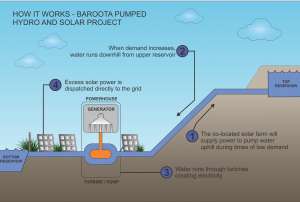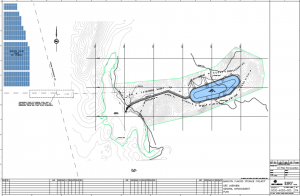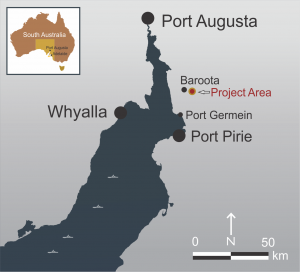Baroota Pumped Hydro Project
Baroota Pumped Hydro Project
Baroota Pumped Hydro Project will provide large scale energy storage to South Australia’s electricity network, storing energy when supply is high and releasing energy when supply is low relative to demand. The Project is being designed for between 200 and 270 MW of capacity and storage for up to 8 continuous hours of generation, providing a new supply of electricity during peak periods of daily demand.
Located 40 kilometres north-east of Port Pirie, the Project is strategically located among the Mid North’s many existing and proposed wind and solar energy projects, and within 1 km of an existing ElectraNet 275kv transmission line. Baroota Hydro Project will store excess energy generated from existing and new renewable energy projects enabling the Mid-North to become a critical source of low cost reliable power to South Australia.
What is Pump Hydro energy storage?
Baroota Pumped Hydro Project stores energy by pumping water to an upper reservoir and then generates electricity by releasing water to a lower reservoir through generation turbines. The two reservoirs provide a closed loop system, recycling water and generating electricity as water is moved between the reservoirs.

Large capacity energy storage is the missing link in South Australia’s power system. Pumped hydro is uniquely placed to fill this gap by storing excess energy at large scale when other forms of renewable energy, for example wind and solar, are abundant. Because of its size, pumped hydro can provide continuous dispatchable power over many hours helping to provide a more reliable and low-cost electricity network.
Pump Hydro is an important opportunity for South Australian energy security.
“Pumped hydro energy storage systems are the most mature electrical energy storage systems available. They are dispatchable with rapid response times, which means they are well placed to balance electricity demand and provide backup for Variable Renewable Energy (VRE) generation. Because pumped hydro is synchronous, it can also provide essential security services, including frequency response, voltage control and black start services”
– Dr Alan Finkel, Independent Review into the Future Security of the National Electricity Market.
Highly suitable site with existing infrastructure
Baroota Pumped Hydro Project creates a new purpose for the existing Baroota Reservoir (lower reservoir) which ceased to be an active part of SA Water’s network in the 1990s and involves the construction of a new (upper) reservoir, water conveyance system, powerhouse and transmission infrastructure. The Project has the potential to be integrated with the co-located Bridle Track Solar Project for direct solar electricity supply for water pumping, and to share transmission connection.


Frequently Asked Questions
Where is the Project located?
The Project is located 40 kilometres northeast of Port Pirie at the site of existing Baroota Reservoir.
The Nukunu people are the Traditional Owners of the land.
What is pumped hydro?
Pumped hydro works by recycling water between two reservoirs or dams to store energy. When there is excess electricity in the network from wind and solar, water is cycled to an upper reservoir. When there is high demand for electricity, water is released to a lower reservoir. The movement of water through a generator creates electricity.
Why is the project being proposed now?
South Australia is leading the nation with high levels of wind and solar power. This means that in times of high wind and solar power generation there can be excess energy supply, and in times of low wind and solar there is a need for ‘on demand’ generation. The need for ‘on demand’ generation can be met by the Project.
The Project will take three and a half (3.5) years to construct meaning an investment decision is needed in 2021 to meet the intended operation start date 2025.
How long will the Project take to build and how long will it operate?
The Project will take three and a half years (3.5) to construct and operate for a minimum of fifty (50) years.
Who will manage the Project?
The project will be managed by UPC\AC Renewables Australia, an established renewable energy company with wind and solar generation projects in development or construction in NSW, Victoria, and Tasmania. A local workforce will be employed to operate the Project.
Through construction and operation of the Project ongoing consultation will be undertaken with Nukunu Traditional Owners and other key stakeholders.
UPC\AC are also the majority owner of the Project. To find out more about UPC\AC, visit the website https://upc-ac.com.
Why is the project located at Baroota Reservoir?
Pumped hydro is suitable in sites with specific conditions including access to electricity transmission, water infrastructure and natural elevation. The project location is strategically located to make use of the existing infrastructure of the Baroota Reservoir and the nearby ElectraNet transmission line. Re-using existing infrastructure supports a highly efficient design and overall economic viability. The project is establishing a new reservoir in an elevated area, approximately 1km to the east of the Baroota Reservoir. This natural elevation provides the height that is needed between the two reservoirs.
Another benefit is that the project location is in the mid-North, an area of high wind and solar generation and where energy storage is needed.
What is the status of the Project?
The project is the most advanced pumped hydro project in South Australia, and among the few prospective projects nationally. The project submitted its development application in July 2018 and Development Approval was granted in February 2019.
Since then, the project proponents have been finalising engineering design and commercial arrangements that will support a final investment decision. A critical focus of the project is engagement with key stakeholders and the Traditional Owners as represented by Nukunu Wapma Thura Corporation (NWT) and will require their support before seeking a final investment decision.
How can I get more information or provide feedback on the project?
To get in touch with the Project team, just email us at baroota@upc-ac.com and we’ll be in touch. We welcome your feedback and enquiries on the Project and look forward to hearing from you.
How can local business and communities get involved?
The Project will cost over $600m to construct, a significant investment in the mid-north region.
The Project will create employment opportunities, with up to 400 people needed during the peak of construction. There’ll be many opportunities for local businesses and the community to get involved. Goods and services that are likely to be sourced locally during construction and operation of the projects include:
- Accommodation and catering
- Engineering
- Construction materials and equipment
- Labour
- Earthworks
- Fencing and landscaping
- Freight
What will be done to protect Aboriginal heritage?
The Project is located in an area that is of important cultural value to the Nukunu people, the Traditional Owners of the land. The project will consult closely with the Traditional Owners as represented by Nukunu Wapma Thura Corporation (NWT) to develop a Cultural Heritage Management Plan. The draft plan:
• prevents construction or other impacts on certain sites including the Baroota Creek; and
• provides heritage training of workers, heritage monitoring and procedures for any discoveries
The Cultural Heritage Management Plan remains a draft and subject to further consultation with NWT.
The Project will require agreement with the Nukunu Traditional Owners prior to proceeding.
What are the benefits for the Nukunu Traditional Owners?
The project recognises the Nukunu Traditional Owners as represented by NWT as a key project partner. A benefit package is subject to further consultation with NWT, with the proposal based on:
- Prioritised employment for Nukunu people (workforce strategies to support specific roles)
- Prioritised access to Nukunu owned or operated businesses
- A yearly payment that properly reflects the cultural value and history of the land (with this yearly payment increasing by inflation for the full 50 year project life)
- A fully funded environment project that meets the requirements of the Sustainable Environmental Benefits program
- Cultural heritage promotion funding and support
The project proposes to work with NWT on a total benefit package that will meet NWT priorities and policies.
What is the impact to the environment?
Any Project like this has localised environmental impacts, but we are committed to avoiding and minimising potential impacts where possible. We’ll be following South Australian Government permit conditions to ensure potential impacts to threatened species and other environmental matters are considered in our design and construction planning. Unavoidable project impacts will be offset and construction areas rehabilitated, in accordance with the approvals for the project.
The total area temporarily impacted by construction is less than 105ha and post-construction, the operational footprint of the Project is less than 65ha.
What approvals are required?
The Project was sponsored by Department of the Premier and Cabinet (DPC) as a public infrastructure project and was assessed under the public infrastructure provisions of Section 49 of the Development Act 1993. This assessment follow a rigous evaluation of environmental, social and economic impacts and how these can be managed.
The Project will also require agreement with the Nukunu Traditional Owners prior to proceeding.
What are the noise impacts?
An extensive noise assessment has been completed, concluding that the Project has been located and designed to prevent adverse impact and conflict between land uses and does not detrimentally affect the amenity of the locality.
During construction, the Environment Protection (Noise) Policy restricts construction activities resulting in noise with an adverse impact on amenity to between 7 am and 7 pm, Monday to Saturday. Noise-generating activities will generally be scheduled within these times.
What will the view be like for those who live and spend time nearby?
We know communities are concerned about how the infrastructure will look and become part of the local landscape. The natural topography of the region is largely effective in minimising direct line of sight to the Project.
Furthermore any potential impacts to visual amenity have been mitigated through design descision such as burying the penstock which connects the upper reservoir to the existing Baroota Reservoir.
What are the environmental benefits of the project?
Wind and solar are becoming the dominant sources of new energy but they are variable. That simply means the sun doesn’t always shine and the wind doesn’t always blow. Energy storage projects like Baroota Pumped Hydro are critical to help fill the gaps when wind and solar aren’t available and ensure power is available when consumers need it.
Often ‘on-demand’ electricity is supplied by emission intensive generators, however the use of green energy storage technologies like pumped hydro means that these gaps in energy supply can be filled with clean low-cost, renewable energy.

